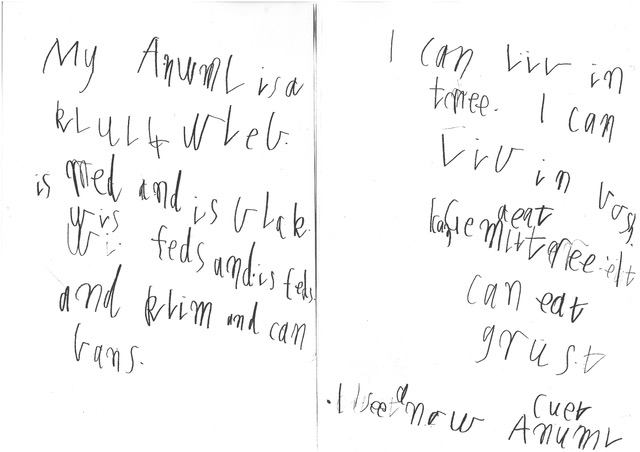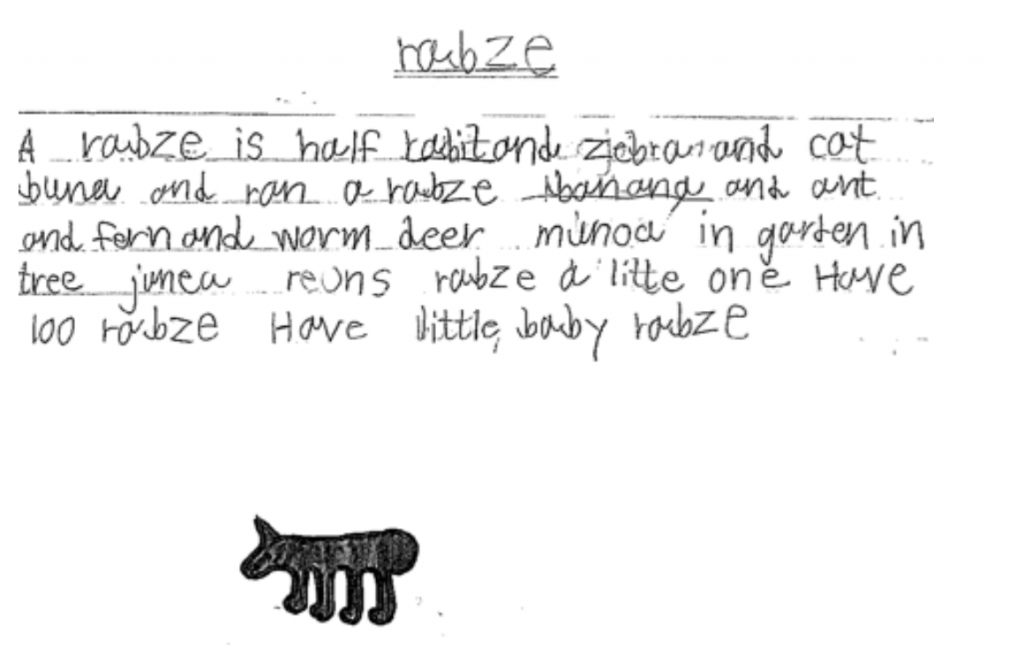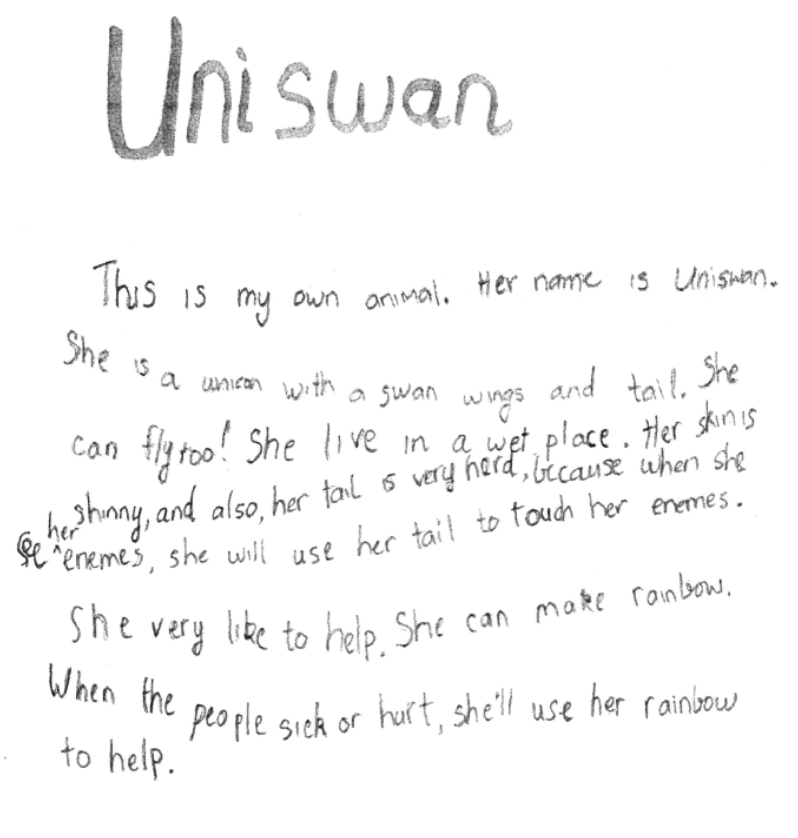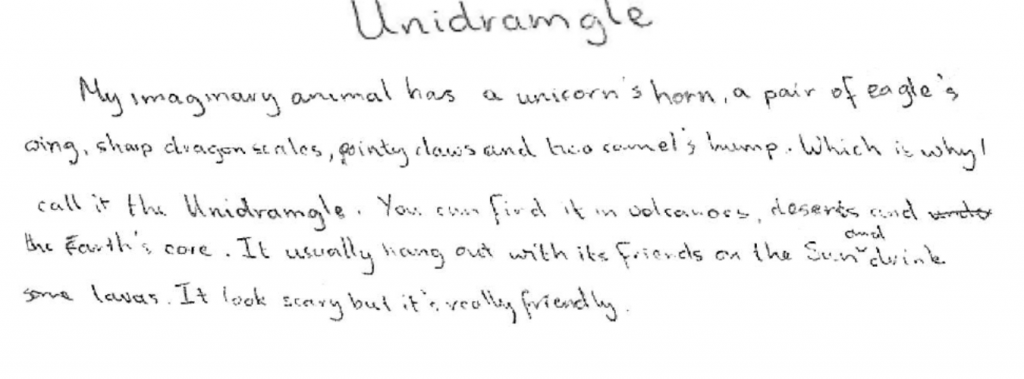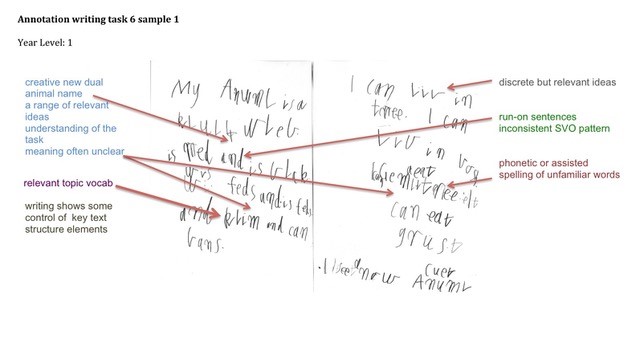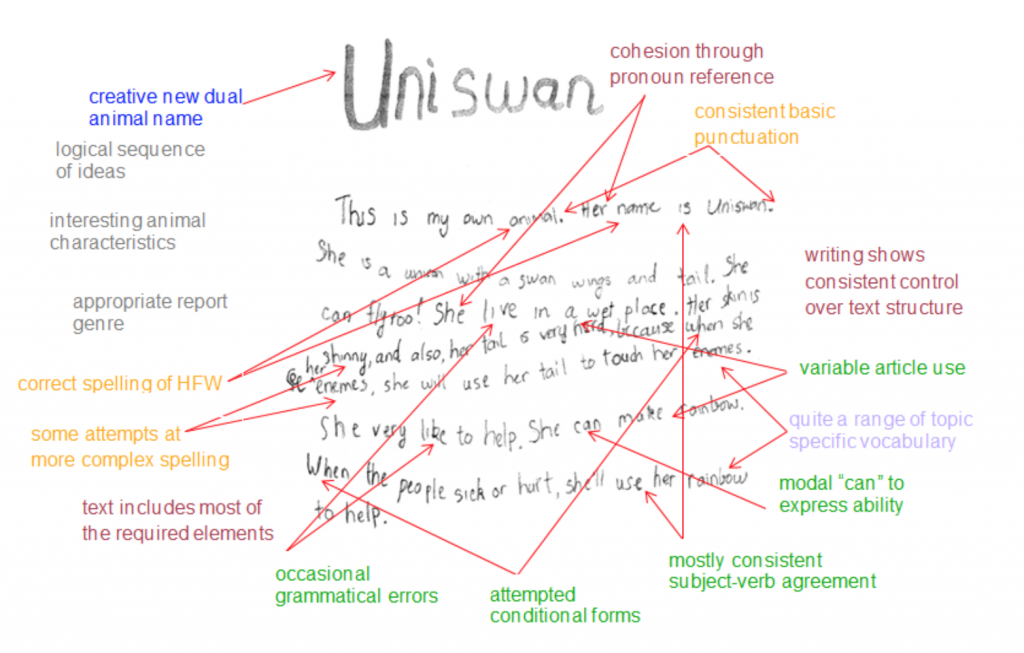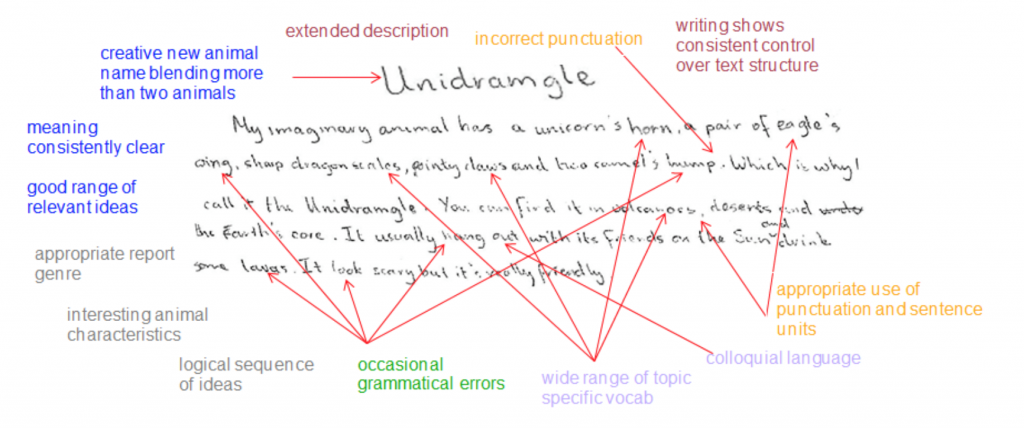6. An imaginary animal
Please click on the toggles below to navigate through information on this assessment task and reveal the links for downloading task materials.
Task details |
|
| Name of writing assessment task | An imaginary animal |
| EAL curriculum level range | A1, A2, BL, B1, B2, CL, C1, C2 |
| Text orientation | Imaginative |
| Task type | Extended response |
Task specification |
|
| Purpose | This task assesses students’ abilities to describe an imaginary animal. It can link to Task 2 which asks students to describe their favourite animal. The task encourages students to create a new animal name by combining two or more known animal names as a heading and to use adjectives to describe the physical appearance and characteristics of their imaginary animal, to use nouns to say where the animal can be found, what it eats and action verbs to write about what their imaginary animal typically does. The task is engaging for most students and is likely to motivate them to stretch their English language resources to complete the task. |
| Description | Students individually complete a description of an imaginary animal based on the teacher’s model. Students illustrate and label their animal. |
| Assumed knowledge and description |
|
Learning/teaching context |
|
| Language centre/mainstream class | Small group |
| Subject/key curriculum objectives, outcomes | English |
| Topic/teaching unit | Animals |
| Assessment conditions |
|
| Notes |
|
Task implementation |
|
| STAGE | ACTION STEPS |
| Pre-assessment activity |
This is a zebrilla. The zebrilla has black and white stripes. It has two hands like a gorilla but two feet like a zebra. It can run fast because it has zebra feet, and can use its two gorilla hands to eat bananas and to make things. It likes eating grass and fruit. It lives in a tree, but it can't climb very well because of its zebra feet. The zebrilla is a big, beautiful animal, but it can be quite scary because it can run so fast.
|
| Assessment activity |
|
| Post-assessment activity |
|
Click here to view the criteria for this assessment:
- TEAL Writing Task 6 – unmarked criteria sheet [PDF]
- TEAL Writing Task 6 – unmarked criteria sheet [Word]
An explanation of the purpose, nature and use of criteria sheets is available at 4. Using the assessment criteria.
Purpose and value of task
As with Task 2 – My favourite animal, this task assesses students’ abilities to write a basic report, but this time about an imaginary animal, made up of at least two other animals. The task usually engages students interest and creativity. Again students are able to use their knowledge about animal habits and attributes they may already know, as well as common vocabulary sets such as body parts, size, foods, colours and so on. The imaginary nature of the task encourages students to be more creative, and to use humour to describe their imaginary animal.
Contextual information
The students in the samples had all taken part in initial discussions around imaginary animals, and had taken part in a teacher modelling of a text.
Commentary
The students all seem engaged in the writing task, producing reports that show imagination and creativity, but which include elements of a report.
Year level: 1
Commentary
The student wrote the text in class, following teaching and learning activities around the topic and task. The class teacher wrote this gloss of the text after the student completed it:
| My [animal] is a [koalaby]. Is red and is [black] [with] [fur] and is [feathers] and [climb] and can [bounce]. I can [live] in tree. I can [live] in [bush]. I can [inserted above] eat [gumtree]. It can eat [grass]. I see a new [inserted above] [cute] [animal]. |
[…] = teacher’s gloss of word
While on first glance, this sample is difficult to interpret for a casual reader, closer analysis using the teacher’s gloss of the text reveals relative sophistication in what the student is trying to communicate.
The sample shows understanding of the task. The student has coined an imaginative dual animal name, the koalaby, which combines the koala and the wallaby, written using + between the parts of the two animal names used. Perhaps following a model text provided by the teacher, the student has also described the animal’s physical characteristics, how the animal moves, its habitat and its diet. There is a concluding comment. This suggests that the student understood the task and the structure and purpose of a descriptive report.
However, problems with mechanics of writing (writing conventions and linguistic structures) render the text largely inaccessible to readers unfamiliar with the context in which it was produced, or without considerable effort at deciphering the intended meaning. The teacher’s transcript makes the text comprehensible and reveals that the student has produced a relatively sophisticated text structure that is well-organised and has appropriate language, including adjectives (red and black) and nouns (fur and feathers) to describe the animal’s appearance and verbs (climbs and bounces) to describe movement.
While there are some appropriate subject-verb-object sentences, there are some grammatical errors, including run-on sentences combining several clauses using and. The text shows a shift in pronouns from third person (it) to first person (I). However, it is not clear whether this is a conceptual error, indicating a shift in reference point within the text, or whether it results from a problem using it as the subject of a sentence.
The transcription shows that the student is attempting to use a range of appropriate vocabulary for the topic. The student is able to spell some high-frequency words correctly (and, in, can, eat). However, problems with spelling present the reader with difficulty in recognising many of the words. The student demonstrates a strong awareness of sound-symbol relationships, especially in relation to consonants, and phonetic-based spelling is used to produce words such as anuml [animal], klim [climb], liv [live], blak [black], bo?sh [bush], cuet [cute] and grust [grass]. However, attempts at other words, such as fur, feathers, bounce, and gumtree are more problematic.
There is some evidence to indicate the student is developing some control over conventions of writing. There is some understanding of upper and lower case letters and most sentences begin with capital letters and end with full stops. However, there is inappropriate use of capital letters in attempts to write animal and gumtree. Other elements of the mechanics of writing are weaker, including letter formation, which creates difficulty in identifying some words such as tree. The letter r in red resembles m, as does the letter n in and. The letters u (in Anuml) and l (in live) often resemble the letter v.
The layout of the text shows understanding of writing in lines from top to bottom, and from left to right, even though the text becomes indented on the second page and has a downward slope.
The marked criteria sheet demonstrates what can be typical of EAL learners at this stage – an unusually wide spread across three levels of performance. Drawing on the teacher’s gloss, some general aspects of the text are at levels 2 and 3, while student meets criteria at level 1 in relation to grammatical features and writing conventions. This illustrates how assessment of EAL learners’ texts should involve balancing criteria in relation to intended meaning and text structure on the one hand and the mechanics of the language (such as grammatical structures and writing conventions) on the other.
The student’s language use in this task is consistent with the descriptions of students at Level A1, Victorian Curriculum F-10 EAL.
TEAL Writing Task 6 – criteria sheet – Sample 1
Using this assessment for further learning
- Recognition of content and high-frequency words
- Ask the student to read the text to you.
- Ask the student to stop when these words are said (black, fur, climb, bounce, live, grass) and follow this procedure:
- point out there is a problem with the spelling of the word
- show the student the correct spelling of the word
- discuss the features of the word, such the letters that spell the word, and the sounds in the word
- ask the student to rewrite the word correctly in their text.
- Writing shorter, focused sentences
- Ask the student to read the text again, taking care to pause where new information is introduced.
- At the end of page one, show the student this worksheet
|
Punctuate this writing with capital letters and full stops to show the sentences. Make it into 2 sentences: it is red and black with fur and feathers it can climb and bounce |
- Ask the student to use the punctuated sentences to re-write page 1 of their text.
- Using it in place of a given subject
- Ask the student to look back at Task 2, and whether they noticed the sentences use it meaning the koalaby, rather than I as in the student’s text. Check that the student understands the use if the pronoun it here.
- Ask the student to replace I with it where appropriate. (Note that I is appropriate in the final sentence.)
- Ask the student to rewrite page 2 of their the text, making sure they use it appropriately, and to use punctuation so there are three sentences (provide any necessary assistance).
Year level: 4
Commentary
This sample shows an understanding of the task. The student has coined an appropriate dual animal name, the 'rabze' which 'half rabbit and half zebra'. However, the meaning of the text is often unclear and there are only a few relevant ideas.
The text suggests that the writer is at the beginning stages of understanding what an appropriate text structure for this kind of task is.
There are identifiable sentences, however there are several 'run-on' sentences. It has inconsistent subject-verb-object patterns. There are frequent grammatical errors and a limited range of readable vocabulary. The student has made interesting attempts to spell new words, which do not always follow readable sound-letter relationships.
The writer is able to form most letters correctly and demonstrates some use of upper and lower case letters to signal sentence units, however there is no use of full stops to clearly separate the paragraph into sentences.
The teacher observed that while the student was completing the assessment task she made extensive use of the model text structure provided. She required a high degree of teacher support in terms of providing vocabulary and copying some of the words and phrases.
The marked criteria sheet shows that the student meets most criteria at level 1 of performance.
The student’s language use in this task is consistent with the descriptions of students at Level B1, Victorian Curriculum F-10 EAL.
TEAL Writing Task 6 – criteria sheet – Sample 2
Using this assessment for further learning
(Select the points you think are currently of most importance to the student.)
Ask the student to read the text aloud. As the student reads, stop them at the end of sentences or sentence-like chunks. Read the sentence back to the student, emphasising how your intonation goes down at the end of a sentence, and show the student that this is where to put a full stop. Show them that the next sentence then has to start with a capital letter. Ask the student to read the sentence again. Elicit and write down any words that the student needs in order to make the intended meaning clearer.
Elicit and write down any words (or correct spellings) that the student needs in order to make the intended meaning clearer.
Focus the student on subject verb object patterns.
Show how you can add more than one noun after the verb that relate to the same verb – eat bananas, eat ants, eat ferns, eat deer etc.
- Rabzes eat bananas (ants, ferns and deer)
- Rabzes have (little) babies
Show how you can add words before the noun to say more about it little, big, beautiful etc.
Give the student time and support to write another draft, which can be added to the student’s portfolio.
Year level: 3
Commentary
This sample shows a good understanding of the task and includes a creative new dual animal name. The spelling of the new word is readable, and shows an understanding of how to combine syllables in English. Meaning is consistently clear and there is clear cohesion via pronoun reference throughout the text.
There is a logical sequence of ideas and the student has included several interesting animal characteristics.
There is evidence of consistent control of text structure and the inclusion of most of the required elements.
Although there are occasional grammatical errors the writing is fluent. The student has used modals correctly and has attempted two conditional sentences, and has varied between simple and more complex sentences. Subject-verb agreement is generally consistent but there are one or two inaccuracies with this, and there is variable article use.
There is quite a wide range of vocabulary items in the text and high-frequency words are generally correctly spelled. There are several attempts at more complex spelling. Sentences are separated by consistent basic punctuation.
This student has made flexible use of the framework provided to communicate her own creative ideas.
The marked criteria sheet shows that the student meets most criteria at level 3 of performance.
The student’s language use in this task is consistent with the descriptions of students at Level B2, Victorian Curriculum F-10 EAL.
TEAL Writing Task 6 – criteria sheet – Sample 4
Using this assessment for further learning
(Select the points you think are currently of most importance to the student.)
Ask the student to read the text to you and discuss any points that you feel need to be clarified. If the student self-corrects while reading, incorporate the corrections onto the draft.
This student has written fluently and in an interesting way. A possible learning focus could be the spelling, in preparation for the student to write a second draft. Ask the student go through the text and underline words they think are, or could be, incorrectly spelt. Ask the student to have another go at spelling them. If they cannot get it correct this time give them the correct spelling, and point out any spelling patterns the words share with words the student already knows.
Ask the student to add these words to their personal dictionaries and to refer to these words when writing the next draft.
Some linguistic issues worth raising are:
Which element of the noun phrase takes the possessive form as in:
- A swan’s wings
Where an intensifier such as ‘very’ goes as in:
- She likes to help very much
- She really likes to help
Subject-verb agreement is generally correct but see if the student can spot and correct the following issues:
- She live in a wet place
- When she see her enemies
- She very like to help
The student may also benefit from thinking about how separate and expand the text into small paragraphs according to:
- introduction
- appearance
- food
- where they live
- what they do
- conclusion.
Give the student time and support to write another draft and add it to their portfolio.
Year level: 6
Commentary
This sample shows a good understanding of the task and includes a creative new name combining four animals – a unicorn, a dragon, a camel and an eagle. Although not completely successful as a pronounceable English word, it is a good understanding at putting syllables together so that they make a new word. The meaning is consistently clear and the text is coherent and confidently written and includes a range of creative and relevant ideas.
The sample provides evidence of an appropriate report genre and includes interesting animal characteristics, a logical sequence of ideas and colloquial language.
The sample shows consistent control of text structure elements and some extended, cohesive description.
There are some grammatical errors in relation to which noun element the plural goes onto in phrases such as ‘eagle’s wings’ and ‘camel’s humps’, and some subject-verb agreement issues. The writer attempted a relative clause which was correct in terms of grammar but separated from the main clause by incorrect punctuation.
A wide range of topic-specific vocabulary was used to describe the animal’s appearance, habitat, activities and food.
The sample demonstrates correct spelling of high-frequency words and more complex words such as volcanoes, deserts and core etc.
The punctuation is generally appropriate with one exception. The student does not use paragraphs.
The student self-corrected on re-reading the text adding some missing words.
The marked criteria sheet shows that the student meets most criteria at level 4 of performance with some at level 3.
The student’s language use in this task is consistent with the descriptions of students working at Level C2, Victorian Curriculum F-10 EAL.
TEAL Writing Task 6 – criteria sheet – Sample 5
Using this assessment for further learning
(Select the points you think are currently of most importance to the student.)
This student needs encouragement to extend his/her writing. During conferencing the student could be encouraged to provide more interest by adding more details about why the Unidramgle lives in ‘volcanoes, deserts and the earth’s core’ – and the sun (because it loves hot places), and more information about its activities when it ‘hangs out with its friends’. Ask the student to say more about what the Unidramgle eats (as well as drinks) especially how it manages in places where there is no lava such as the desert.
The main grammatical issue in this text is the student doesn't seem to understand yet which element of the noun phrase takes the possessive form, and which element takes the plural form in phrases such as:
- A pair of eagle’s wings
- Two camel’s humps
As the student is attempting to write this feature, now is an appropriate time to point out how it works.
- The student generally adheres to appropriate subject verb agreement but see if s/he can spot and correct the following issues:
- It usually hang(s) out with….
- It look (s) scary
- Give the student time and support to write another more detailed draft.

